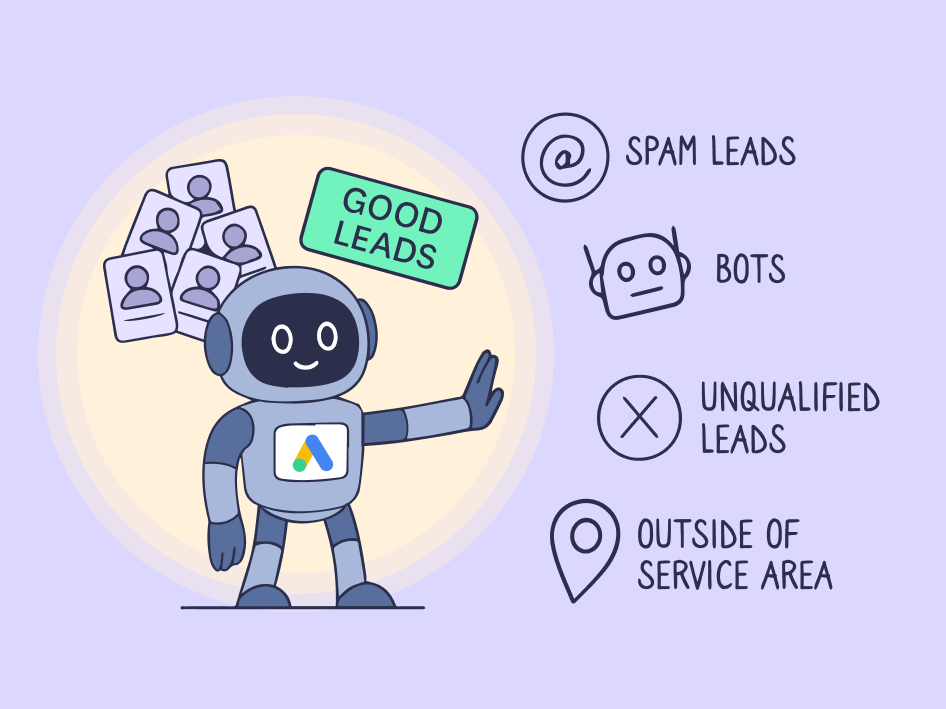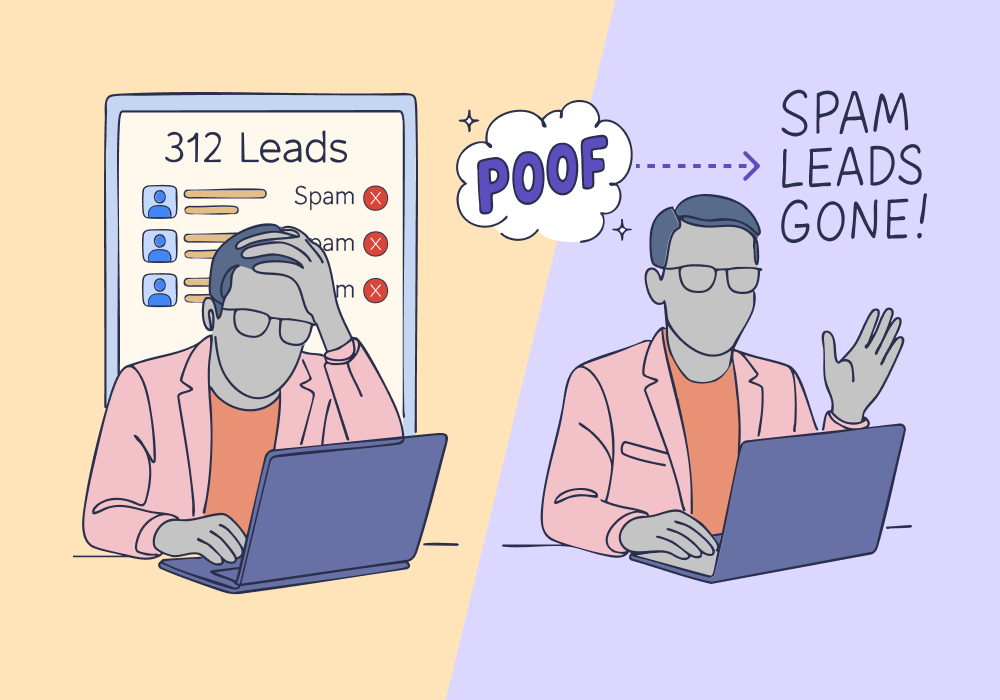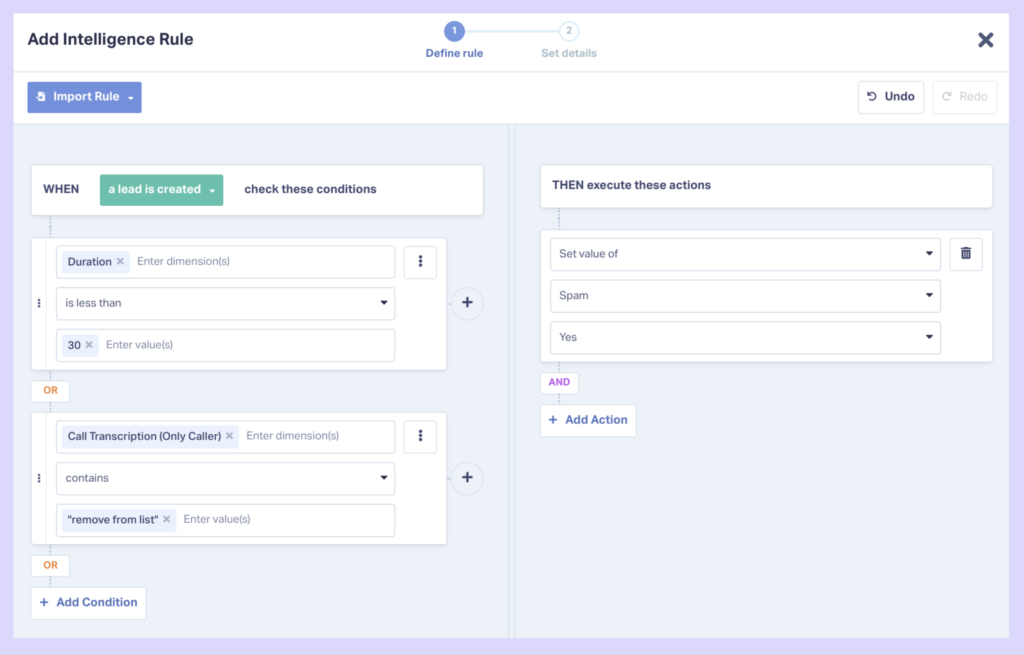
What if every wasted click could be stopped before it even hits your budget?
Just like an ad blocker prevents pop-ups from ever loading, you can teach your campaigns to ignore traffic that’s never going to convert.
Spam calls, bot form fills, and low-intent inquiries don’t just fail to convert—they dilute your conversion data and slow down optimization. By sending enhanced conversion data back to Google Ads, you train the algorithm to block these clicks automatically, keeping your campaigns focused on the leads that actually matter.
The result: cleaner data, smarter optimization, and less wasted spend—all without manual exclusions, IP blocks, or endless negative keyword lists.
The Hidden Harm of Bad Clicks
Most marketers think of a spam lead as a minor annoyance. We’ll qualify it out. No big deal.
The real harm is everything that happens upstream:
1. You pay for the click
Bots, spam forms, accidental taps—Google charges you for all of it.
2. That click counts as a conversion
If you’re using basic tracking, Google treats every call or form fill as a “win.”
3. Bad conversions pollute your signals
Google can’t tell a $0 dead-end from a high-value opportunity, so harmless-looking spam quietly pushes your bidding strategy toward:
- Low-intent search terms
- Cheap audiences
- Junk placements
- Traffic sources that produce “easy conversions,” not real leads
This is how wasted spend compounds, even when you never work those leads.
But the bigger problem is that spam clicks do more than just waste money—they distort the algorithm that decides how you spend the rest of your budget.
The Fix: Filter Out Bad Click Patterns Before They Reach Your Wallet
You can’t stop a bot from clicking an ad, but you can stop Google from chasing the traffic patterns that produce them.
When you send Google detailed data about your leads, including which were qualified and which were junk, it learns the difference between:
- Search terms that produce real opportunities
- Search terms that attract spam
- Audiences that send buyers
- Audiences that send bots or low-intent clicks
Over time, Google deprioritizes the traffic patterns tied to bad clicks. You spend less on garbage before it ever appears in your account.
That’s the ad-blocker effect: the bad stuff gets filtered out early, before it slows everything down.
Where WhatConverts Fits In
WhatConverts makes this filtering possible by giving Google the one thing it can’t get on its own: clear signals about lead quality and value.
With WhatConverts:
- Every call, form, and chat is qualified
- Spam, wrong-service, and low-intent leads are marked clearly
- Lead value and booked revenue flow back into Google
- Google learns which conversions matter—and which ones should be ignored
Instead of optimizing for “conversions,” your campaigns optimize for useful conversions.
Agencies don’t have to filter out spam; Google learns to stop chasing it in the first place.
Inside WhatConverts: How It's Done
Setting up automatic spam blocking within WhatConverts is easy. Just navigate to Lead Intelligence and build a qualification rule based on qualities like:
Duration:
- Phone calls under 60 seconds → Unqualified (adjust threshold for your business)
- Calls under 10 seconds → Spam (obvious robocalls/disconnects)
Content:
- Call transcript contains "remove from list" → Spam
- Form message mentions services you don't offer → Unqualified: Wrong Service
- Call transcript includes "just looking" or "comparing prices" → Unqualified: Low Intent
Then instruct Lead Intelligence to set Spam value to "yes" for any calls that meet these criteria.
Real Results: How Gumpo Cut CPA by 78% Using Lead Quality Filtering
A UK weight loss provider was wasting budget on spam calls and bot form fills that Google counted as "conversions." Agency partner Gumpo used WhatConverts to filter out the junk—sending only qualified conversions back to Google Ads.
By training the algorithm with clean data (calls over 60 seconds, qualified leads with real quote values), campaigns stopped chasing spam traffic patterns. In just three months:
- Unique lead submissions jumped 336%
- Qualified phone calls increased 293%
- Cost per acquisition plummeted 78% (from £174 to £38)
The algorithm wasn't just blocking spam—it was learning which traffic sources, keywords, and audiences produced genuine buying intent, then automatically allocating budget toward those patterns.
Read More: How to Earn 336% More Leads from a Dying PPC Campaign [Case Study]
The Bottom Line
You can’t stop every bad click from happening, but you can stop Google from thinking they’re good clicks.
Give Google accurate data about which leads are valuable and which ones aren’t, and it begins filtering traffic the way your browser filters pop-ups: quietly, automatically, and before the harm occurs.
Ready to stop paying for bot clicks and start filtering out worthless traffic before it costs money? Start your free WhatConverts trial and set up enhanced conversions in minutes.
Get a FREE presentation of WhatConverts
One of our marketing experts will give you a full presentation of how WhatConverts can help you grow your business.
Schedule a Demo
Grow your business with WhatConverts







